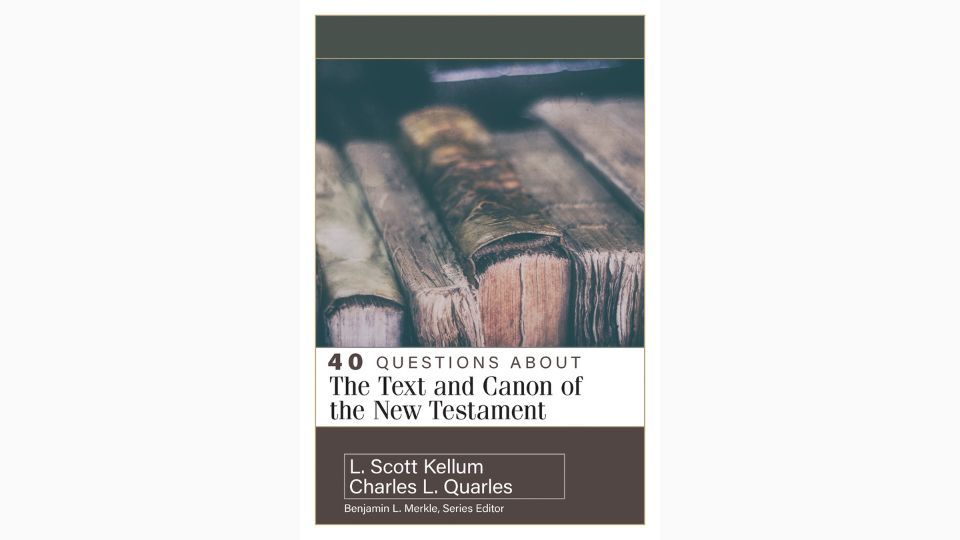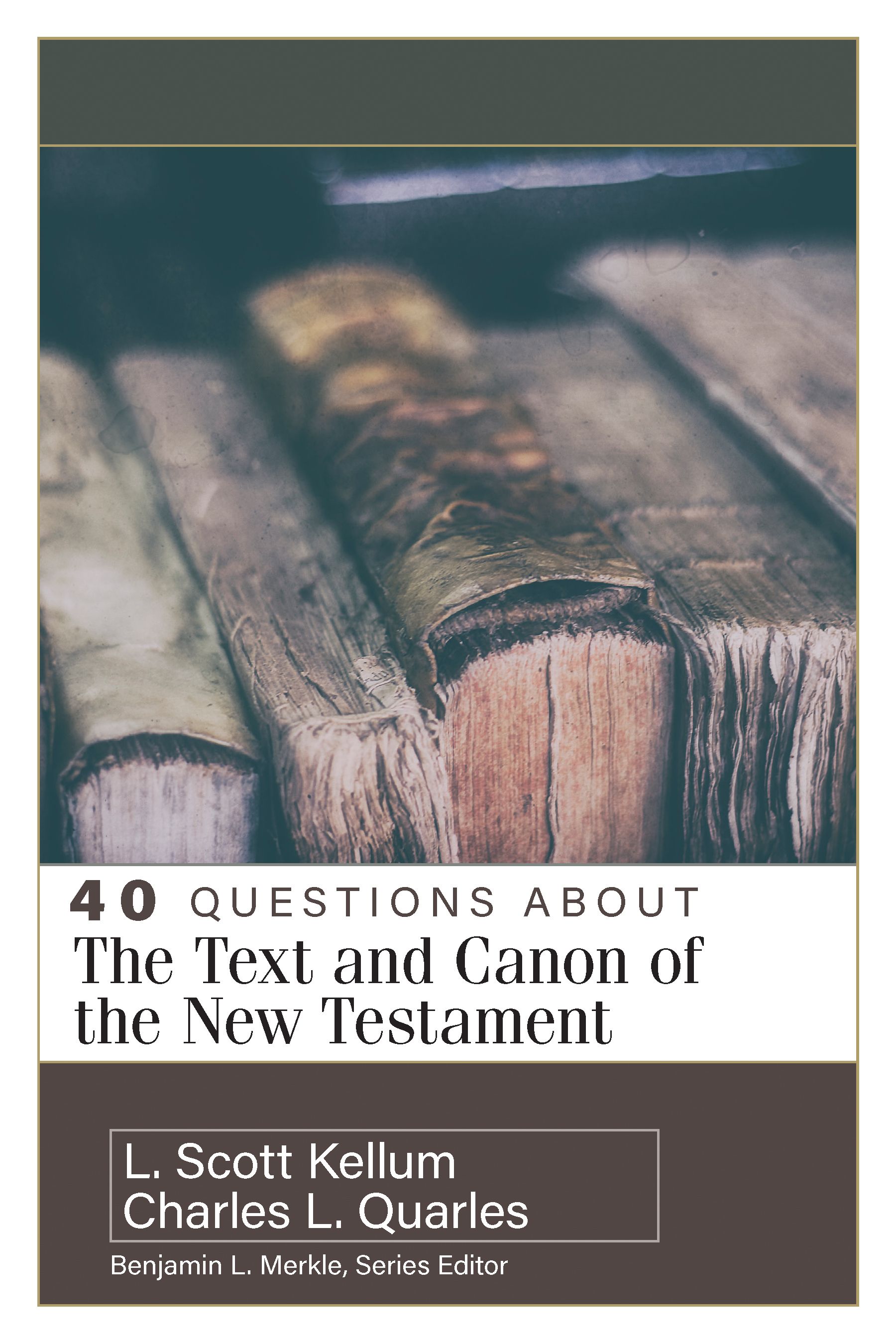The Text and Canon of the New Testament
How can we obtain the original text of the New Testament without existing autographs, and how do we know what books compose the New Testament.

40 Questions About the Text and Canon of the New Testament is a 350 page book written by Charles L. Quarles and L. Scott Kellum and published by Kregel Academic in 2023. Charles L. Quarles (PhD, Mid-America Baptist Theological Seminary) serves as research professor of New Testament and biblical theology at Southeastern Baptist Theological Seminary. L. Scott Kellum (PhD, Southeastern Baptist Theological Seminary) is a senior professor of New Testament and Greek at SEBTS.
1. Purpose of 40 Questions About the Text and Canon of the New Testament
The purpose of this book is to question the fundamental question, "What is the New Testament?" It does so by answering two distinct questions: (1) What books compose the New Testament, and what is the original text of those books? (15)
2. Content of 40 Questions About the Text and Canon of the New Testament
The book is divided into two parts. Part 1, written by Quarles, addresses the transmission of the New Testament text, the current availability of New Testament manuscripts, and the history, theories, and practice of textual criticism. Part 2, written by Kellum, reviews the definition and theories of Canon, the physical evidence of Canon, and the literary and theological dimensions of Canon.
Part I: The Text of the New Testament
A. Transmission
- The original text contained in the original manuscripts have been preserved even though the original manuscripts no longer exist.
- The NT autographs were destroyed during the first few centuries by aging and persecution.
- Scribes made mistakes copying the NT, but these errors are easily spotted and can be determined and do not impact the meaning of the text.
- The NT manuscripts available today are more numerous than any other ancient book, and they enable scholars to establish the original readings of the NT.
- There is little evidence of any effort to adapt the NT text to change the theology taught in the text.
B. New Testament Manuscripts
- There are around 500,000 variants in all the manuscripts of the Greek NT.
- Textual variants may affect the meaning of the text, but no essential doctrine of the Christian faith depends on a textual variant that remains in question.
- The differences in the manuscripts available to us do not undermine an informed doctrine of inspiration and inerrancy.
- Newly discovered manuscripts tend to confirm and at most fine-tune our Greek NT editions.
C. Textual Criticism
- Textual criticism seeks to establish the original text of the Greek NT using the scientific method.
- NT textual criticism is an ancient practice, but there are new developments in the field today.
- The three major NT text types established in the 19th and 20th century are the (1) Alexandrian, (2) Western, and (3) Byzantine.
- Some prefer a Byzantine priority, while "reasoned eclectics" look at a variety of witnesses and give attention to internal evidence.
- The four recent major editions of the Greek NT are the Nestle-Aland (NA), the United Bible Society (USB), the Society of Biblical Literature (SBL), and the Tyndale House (THGNT).
- Helpful tools include textual commentaries, the Editio Critica Maior (ECM), the CNTTS Apparatus, the Institute for NT Textual Research website, and the Center for the Study of NT Manuscripts website.
- The short ending of Mark (16:8) is preferred to the long ending (16:9–20).
- John 7:53–8:11 does not appear to have been an original part of the gospel of John.
- The Coherence-Based Genealogical Method (CBGM) is "a method that (1) uses a set of computer tools (2) based in a new way of relating manuscript texts that is (3) designed to help us understand the origin and history of the New Testament text." (185)
Part II: The Canon of the New Testament
- Three models of understanding Canon
- Extrinsic: the canon was chosen by a natural, historical process.
- Magisterial: the church selected the canon.
- Intrinsic: the NT canon is self-authenticating. Therefore, the church did not select the canon but recognized what God has done in these books. (204)
- The term graphe has a broad semantic domain and does not strictly refer to Scripture in the modern sense.
- The OT canon was fixed by the second century BC at the latest.
- The early councils were not about selecting a canon but recognizing a set of books as canonical.
- The earliest Christians valued contemporaneous documents as Scripture.
- External pressure had little to no effect on the formation of the NT canon.
- Books excluded from the canon were quickly rejected if ever considered. Lingering debates centered on books included in the canon (Hebrews, Revelation, and the minor general epistles).
- The canon is closed, and it is a permanent closure.
- Theological implications of the NT canon include Scripture's inspiration, its authority, and its necessity for theology.
- Hermeneutical implications of the NT canon require Scripture be read as a united whole, read with equal value, and read progressively.
3. Commentary of 40 Questions About the Text and Canon of the New Testament
This resource is two books in one. It is a readable resource for Christians on (1) the transmission of the New Testament text and (2) the canon of the New Testament. Overall, the authors succeed in providing a comprehensive volume that answers the question, "What is the New Testament?" Like other books in the 40 Questions Series, this format is effective as an extensive Frequently Asked Questions (FAQ) of textual criticism and NT canon.
I found Part I of this book to be the stronger half. Organizing this section into the three topics of transmission, manuscripts, and textual criticism was natural, logical, and clear. The content should satisfy most evangelical Christians who have questions about the reliability of the New Testament text and how we obtained our current modern editions of the Greek New Testament.
Part II covers fully all the major topics of the NT Canon (definition and method, history, apologetics/defence, and evidence), but the order and length of each topic was not to my personal preference. For example, the most important topic of method (extrinsic vs intrinsic found in chapters 21 and 22) could have used more space while shortening or removing topics that are minor and peripheral. Part II remains an excellent reference for everyday Christians since one can look up a specific question and likely find a succinct, satisfactory discussion.
The discussion on the theological and hermeneutical implications of the NT canon provides thoughtful application to the Christian reading Scripture. The reflection questions insure readers grasped the most important concepts of each chapter. A guide to suggested books for further study would have been helpful for readers wanting to delve deeper, but perhaps looking up resources referenced in the numerous footnotes would still suffice.
4. Comparison Analysis
Part I is now my preferred resource for the basics of New Testament transmission and textual criticism and replaces NT Textual Criticism: A Concide Guide by David Alan Black. A five page summary on the Coherence-Based Genealogical Method is found in chapter 20, but given its growing influence in the present and future, A New Approach to Textual Criticism is recommended to supplement this topic.
Part II is a satisfactory companion to Part I, and it may be enough for many readers as a reference work and not a portion of the book to be read cover to cover. But for those wanting to understand the New Testament canon more fully from an intrinsive model viewpoint, I heartily recommend Question of Canon: Challenging the Status Quo in the New Testament Debate and Canon Revisited: Establishing the Origins and Authority of the New Testament by Michael Kruger.
5. Final Thoughts
40 Questions About the Text and Canon of the New Testament is an excellent, accessible book to help Christians understand how we possess the Greek New Testament, its original text and its twenty-seven books. For Christians wanting to have a well-organized reference that can also be read from cover to cover, this is now probably the best book available today.

40 Questions About the Text and Canon of the New Testament
Written by Kellum and Quarles | Kregel Academic (2023)




